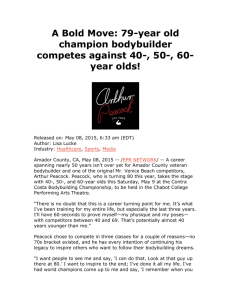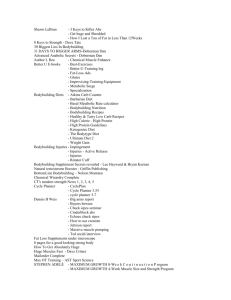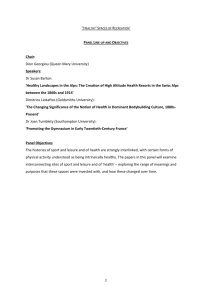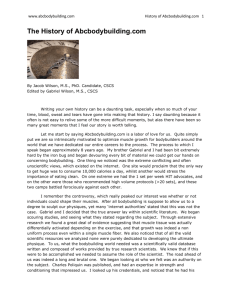Bodybuilding.com - 5 Strategies For Healing & Rehabilitation Using
advertisement
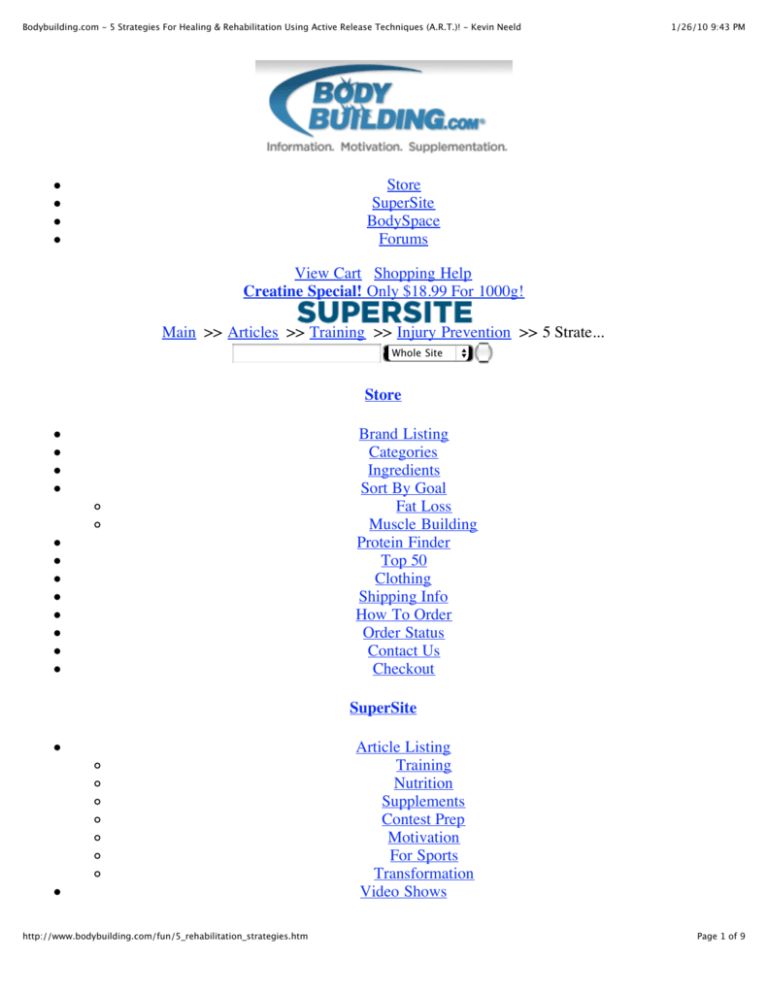
Bodybuilding.com - 5 Strategies For Healing & Rehabilitation Using Active Release Techniques (A.R.T.)! - Kevin Neeld 1/26/10 9:43 PM Store SuperSite BodySpace Forums View Cart Shopping Help Creatine Special! Only $18.99 For 1000g! Main >> Articles >> Training >> Injury Prevention >> 5 Strate... Whole Site Store Brand Listing Categories Ingredients Sort By Goal Fat Loss Muscle Building Protein Finder Top 50 Clothing Shipping Info How To Order Order Status Contact Us Checkout SuperSite Article Listing Training Nutrition Supplements Contest Prep Motivation For Sports Transformation Video Shows http://www.bodybuilding.com/fun/5_rehabilitation_strategies.htm Page 1 of 9 Bodybuilding.com - 5 Strategies For Healing & Rehabilitation Using Active Release Techniques (A.R.T.)! - Kevin Neeld 1/26/10 9:43 PM Exercises Workouts For Women For Teens Contests Bodybuilders Writer Listing Newsletter Community Forum BodySpace BodyBlogs BodyGroups Product Reviews Photo Gallery Printable page Did you know? Scapular stability is often a weak link amongst lifters that prevents them from breaking through a plateau. The beneficial nature of A.R.T. leads a large population of individuals with diverse and unique injuries to pursue treatment. Here are 5 strategies that can be used to release tension and promote better healing. Learn more. By: Kevin Neeld Article Summary: If your body is not symmetrical, perform extra work on the slower side. Scapular dysfunction refers to a scapulae movement abnormality. http://www.bodybuilding.com/fun/5_rehabilitation_strategies.htm Page 2 of 9 Bodybuilding.com - 5 Strategies For Healing & Rehabilitation Using Active Release Techniques (A.R.T.)! - Kevin Neeld 1/26/10 9:43 PM An abnormally tight subclavius will affect shoulder movement. 5 Things I Learned From A.R.T. I recently had my first visit with an A.R.T. practitioner. For those of you that aren't familiar with this practice, A.R.T. stands for active release technique. In the pursuit of oversimplification, we can think of A.R.T. as a unique soft-tissue technique that helps release tension affecting muscles, tendons, ligaments, nerves, and the fascia surrounding these structures. A.R.T. is especially effective at breaking up scar tissue, which can negatively affect the pliability of the surrounding tissues in the body. The beneficial nature of A.R.T. leads a large population of individuals with diverse and unique injuries to pursue treatment. Having a constant supply of hurt people to talk to puts A.R.T. practitioners in a prime position to develop expertise in the areas of injury mechanisms and healing/rehabilitation strategies. In addition to and receiving an effective shoulder treatment, I also learned: 1. A Loss Of The Natural Curve In The Cervical Spine Is Common Among Students. The result can be either a relatively curve-less cervical spine or a slight curve in the opposite direction (anterior concavity). This is a common result from reading and writing papers on your desk, with your neck flexed to help you look down. This also puts the muscles of the back of your neck on a stretch and constant tension, a recipe for injury. Injury Prevention Articles: Keep Back Pain From Taking Over Your Life! - By Christopher Mohr Back Pain: How Exercise Can Help. - By David Robson Bodybuilding Sins That Cause Back Pain. - By Jesse Cannone Other Injury Prevention Articles... You can help minimize the risk of this maladaptation by placing your reading material directly in front of your face, with your neck in a neutral position. Also, find an arm rest that allows your shoulders to maintain a neutral position. If the arm rest is too high, the upper trapezius muscle can become shortened. If the arm rest is too low, the rhomboids become overactive. http://www.bodybuilding.com/fun/5_rehabilitation_strategies.htm Page 3 of 9 Bodybuilding.com - 5 Strategies For Healing & Rehabilitation Using Active Release Techniques (A.R.T.)! - Kevin Neeld 1/26/10 9:43 PM Click Image To Enlarge. The Natural Curve Of The Spine. As a result of either of these situations, there is a compensatory shortening of one of the muscles attaching to the scapulae, negatively affecting scapular positioning and scapulohumeral rhythm. 2. Muscles On One Side Of The Body May Respond To Training Differently Than Muscles On The Opposite Side. This may or may not be due strictly to injury. For instance, an injury to, let's say-the left shoulder, may result in surrounding muscles becoming weak and/or inhibited, not responding to training the same as muscles on the right side. However, it is also possible that these muscles don't respond to training the same as the other side, which could predispose that side to injury. Sometimes some soft tissue work will free up some of the tension in a muscle, changing the way that muscle, and several surrounding muscles adapt to a training stimulus. This is especially true when a muscle becomes tight and is not responding to stretch. RELATED ARTICLE Author: Charles Glass Shoulder Injuries! I had been bodybuilding for a while but had to clean and jerk most my weight because I trained in a garage gym alone. [ Click here to learn more. ] While this tightness could be due to a number of factors (scar tissue, trigger points, hyperactivity due to weak synergists, etc.), continually stretching the muscle may actually increase the tightness, as the muscles activates as a protective mechanism. Soft tissue treatment manages to break this cycle, allowing the tissue to respond to stretching. http://www.bodybuilding.com/fun/5_rehabilitation_strategies.htm Page 4 of 9 Bodybuilding.com - 5 Strategies For Healing & Rehabilitation Using Active Release Techniques (A.R.T.)! - Kevin Neeld 1/26/10 9:43 PM 3. Building On The Last Point, Sometimes Unbalanced Programming Is Necessary To Create Balance. If you have one side of your body that is not responding to training like the other side, it may be necessary to do some extra work on the "slower" side. This may be an extra set, a few extra reps, beginning with a higher intensity load, etc. I generally approach this by performing 3 sets on the bum side, and 1 set on the good side. I know this may seem like a novel suggestion, but think about it. If you break your left arm, do you get both arms casted? Bilateral asymmetries require specific training measures to recreate balance. In the timeless words of wisdom from Florence Kendall, "The object is to use asymmetrical exercises to bring about optimal symmetry." Click Image To Enlarge. Bilateral Asymmetries Require Specific Training Measures To Recreate Balance. Another interesting suggestion, which I had never heard before, was to perform some sort of rapid movements using the muscles on the lagging side prior to the workout. Rapid, ballistic contractions provide a unique stimulus to the nervous system driving that muscle that may help wake it up. The take home: training both sides equally and expecting the "slower" side to catch up may be an inefficient way to create symmetry. Bilateral asymmetry is a big factor in injury risk, so symmetry is important! 4. Small Muscles Can Have A Big Impact. I've always felt that my subclavius was slightly tighter on my left side than on my right. I was correct. The subclavius, an anatomical afterthought, connects the first rib to the clavicle (collarbone) and serves to pull the collarbone down and forward. An abnormally tight subclavius will negatively affect any shoulder movement action that involves rotation or upward movement of the collarbone (most of them). http://www.bodybuilding.com/fun/5_rehabilitation_strategies.htm Page 5 of 9 Bodybuilding.com - 5 Strategies For Healing & Rehabilitation Using Active Release Techniques (A.R.T.)! - Kevin Neeld 1/26/10 9:43 PM Click Image To Enlarge. An Abnormally Tight Subclavius Will Negatively Affect Shoulder Movement. It can also negatively affect breathing by altering the compression and expansion dynamics of the rib cage. This tightness seems to respond well to self-massage, which is a good thing, since it saves us the embarrassment of walking into the office of a manual therapist complaining of a locked-up subclavius! 5. Paying Attention To The Muscles That Control The Scapulae Is Worthwhile. This isn't something I learned as much as a positive reinforcement on something I was pretty sure about. Generally speaking, scapular dysfunction refers to any movement abnormality of the scapulae, typically due to some sort of muscular dysfunction. Muscular dysfunction refers to a muscle not firing at the right time or not producing enough force. Adding a few exercises to work the muscles that control scapular movement to your program can have profoundly positive affects on your progress. Unfortunately, your body is extremely effective at protecting itself, sometimes at the expense of strength gains. I know. I don't like it either, but it's true. Strength Articles: Get Big & Strong: The Best Of Both Worlds! - By Michael Roussell Hybrid Strength And Hypertrophy Training! - By Par Deus Forgotten Methods Of Building Strength & Size! - By Josh Henkin Other Strength Articles... Scapular stability is often a weak link amongst lifters that prevents them from breaking through a plateau. Think of trying to produce forceful pushing movements with an unstable scapula as firing a cannon from a canoe. It doesn't matter how much power you can generate if you don't have a stable platform from which to produce that power. Try adding exercises to improve the strength of your serratus anterior (scap push-up), lower trapezius (straight arm dip-off bench), and rhomboids (inverted scap row). Strengthening these muscles will improve the quality of scapulohumeral rhythm (the synergistic movement of the scapula and humerus), allowing for safer, more efficient movements of the upper http://www.bodybuilding.com/fun/5_rehabilitation_strategies.htm Page 6 of 9 Bodybuilding.com - 5 Strategies For Healing & Rehabilitation Using Active Release Techniques (A.R.T.)! - Kevin Neeld 1/26/10 9:43 PM extremity. It will also probably alleve many of the nagging shoulder injuries common to lifting. Conclusion Whether you're a competitive athlete, weekend warrior, or a physical laborer, A.R.T. may help alleviate some of your pain and release your tissue restrictions, allowing you to avoid injury and continue making progress in your training. Take care of your body and it'll take care of you... About The Author: Kevin Neeld, CSCS has helped athletes of all ages fulfill their athletic potential. Through the application of functional anatomy, biomechanics, and neural control, Kevin specializes in guiding athletes to optimal health and performance. He can be reached by email at kn@prodigyperformancetraining.com or through his website at www.KevinNeeld.com. kn@kevinneeld.com Recommend this article to a friend by e-mail here! http://www.bodybuilding.com/fun/5_rehabilitation_strategies.htm Page 7 of 9 Bodybuilding.com - 5 Strategies For Healing & Rehabilitation Using Active Release Techniques (A.R.T.)! - Kevin Neeld 1/26/10 9:43 PM Back To Kevin Neeld's Main Page Back To The Articles Main Page. Related Articles Work Those Legs Injury Free Training Are You Developing Your Calves To Break Your Ankles And ACL? Back To Top Prolab Naturally Lean Complex Prolab Naturally Lean Complex is THE meal supplement for a lean body. Learn More! Member Login Sign in for more FREE features and tools! Username or Email Address: Password: Remember Me Forgot your Username or Password? Log In New to Bodybuilding.com? Sign Up Now It's FREE! http://www.bodybuilding.com/fun/5_rehabilitation_strategies.htm Page 8 of 9 Bodybuilding.com - 5 Strategies For Healing & Rehabilitation Using Active Release Techniques (A.R.T.)! - Kevin Neeld 1/26/10 9:43 PM Bodybuilding.com Newsletter Give Us Feedback: Report A Problem Site Feedback Follow Us: Twitter Receive exciting features, news & special offers from Bodybuilding.com Facebook RSS Feeds Enter your e-mail address Home | Store | Products | Careers | Help | Contact Us | Terms of Use | Search | About Us | Checkout © Bodybuilding.com, 2026 S Silverstone Way, Meridian, ID 83642 USA - 1-877-991-3411 http://www.bodybuilding.com/fun/5_rehabilitation_strategies.htm Page 9 of 9

